Exploring Parental Engagement in Computational Mathematics Report
VerifiedAdded on 2020/05/16
|39
|11699
|70
Report
AI Summary
This report explores the nature of engagement between learners and their parents in computational and mathematics thinking activities. It investigates how students and parents interact during these activities, the roles parents play, and the benefits and challenges of parental involvement. The research aims to answer specific questions about student-parent interactions, parental roles, and the impact of these activities. The study's purpose is to explore these engagements, discover the role of parents, and assess the benefits and challenges involved. The research is significant as it focuses on computational thinking in schools, involving workshops for elementary students and their parents. The study also highlights the importance of computational thinking activities in mathematics education and the potential of computational tools to benefit both students and parents. The theoretical framework is based on constructionism and social constructivism, emphasizing learning through making and active social environments. The research draws on the work of Papert, Bruner, and Kotsopoulos, among others, to support the integration of computational thinking in mathematics education.
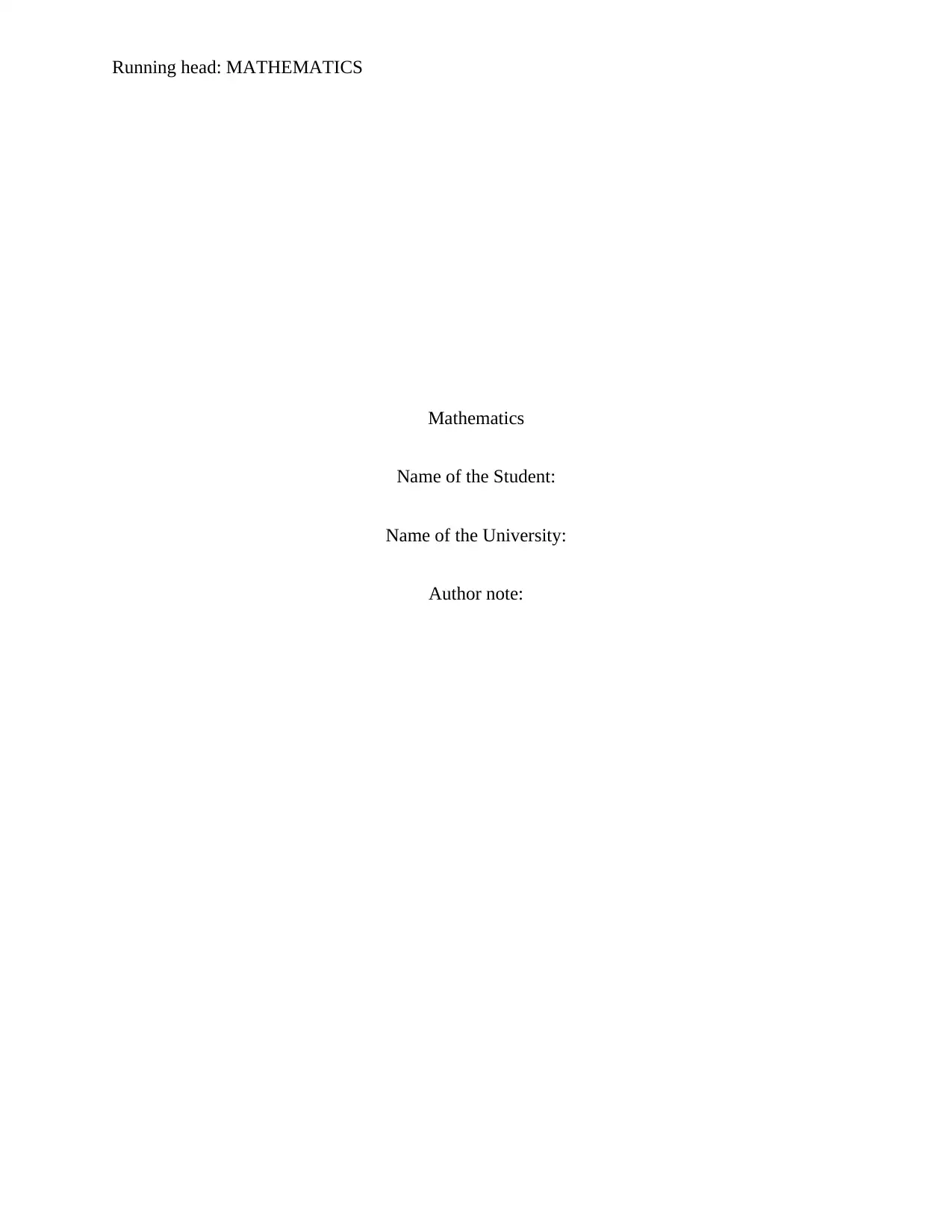
Running head: MATHEMATICS
Mathematics
Name of the Student:
Name of the University:
Author note:
Mathematics
Name of the Student:
Name of the University:
Author note:
Paraphrase This Document
Need a fresh take? Get an instant paraphrase of this document with our AI Paraphraser
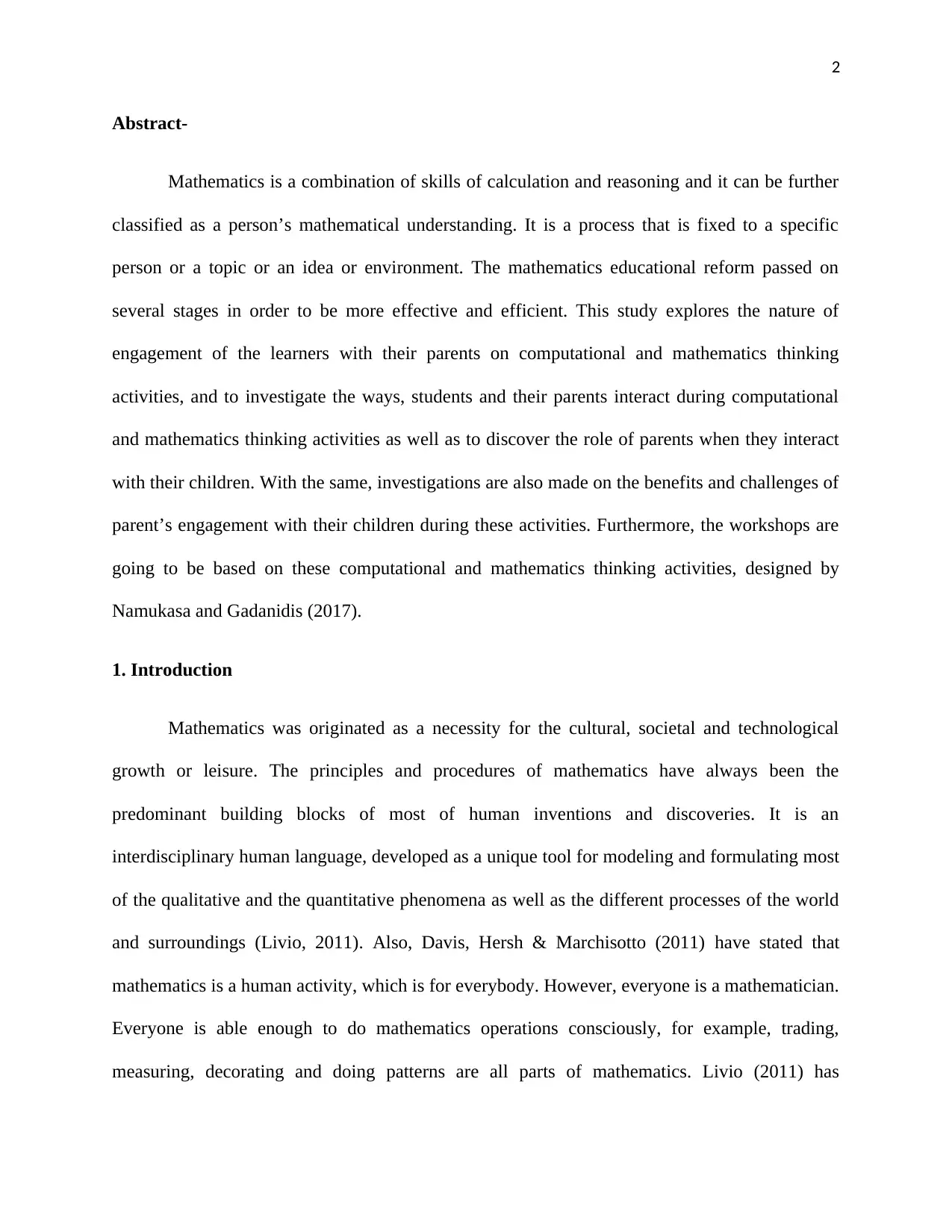
2
Abstract-
Mathematics is a combination of skills of calculation and reasoning and it can be further
classified as a person’s mathematical understanding. It is a process that is fixed to a specific
person or a topic or an idea or environment. The mathematics educational reform passed on
several stages in order to be more effective and efficient. This study explores the nature of
engagement of the learners with their parents on computational and mathematics thinking
activities, and to investigate the ways, students and their parents interact during computational
and mathematics thinking activities as well as to discover the role of parents when they interact
with their children. With the same, investigations are also made on the benefits and challenges of
parent’s engagement with their children during these activities. Furthermore, the workshops are
going to be based on these computational and mathematics thinking activities, designed by
Namukasa and Gadanidis (2017).
1. Introduction
Mathematics was originated as a necessity for the cultural, societal and technological
growth or leisure. The principles and procedures of mathematics have always been the
predominant building blocks of most of human inventions and discoveries. It is an
interdisciplinary human language, developed as a unique tool for modeling and formulating most
of the qualitative and the quantitative phenomena as well as the different processes of the world
and surroundings (Livio, 2011). Also, Davis, Hersh & Marchisotto (2011) have stated that
mathematics is a human activity, which is for everybody. However, everyone is a mathematician.
Everyone is able enough to do mathematics operations consciously, for example, trading,
measuring, decorating and doing patterns are all parts of mathematics. Livio (2011) has
Abstract-
Mathematics is a combination of skills of calculation and reasoning and it can be further
classified as a person’s mathematical understanding. It is a process that is fixed to a specific
person or a topic or an idea or environment. The mathematics educational reform passed on
several stages in order to be more effective and efficient. This study explores the nature of
engagement of the learners with their parents on computational and mathematics thinking
activities, and to investigate the ways, students and their parents interact during computational
and mathematics thinking activities as well as to discover the role of parents when they interact
with their children. With the same, investigations are also made on the benefits and challenges of
parent’s engagement with their children during these activities. Furthermore, the workshops are
going to be based on these computational and mathematics thinking activities, designed by
Namukasa and Gadanidis (2017).
1. Introduction
Mathematics was originated as a necessity for the cultural, societal and technological
growth or leisure. The principles and procedures of mathematics have always been the
predominant building blocks of most of human inventions and discoveries. It is an
interdisciplinary human language, developed as a unique tool for modeling and formulating most
of the qualitative and the quantitative phenomena as well as the different processes of the world
and surroundings (Livio, 2011). Also, Davis, Hersh & Marchisotto (2011) have stated that
mathematics is a human activity, which is for everybody. However, everyone is a mathematician.
Everyone is able enough to do mathematics operations consciously, for example, trading,
measuring, decorating and doing patterns are all parts of mathematics. Livio (2011) has
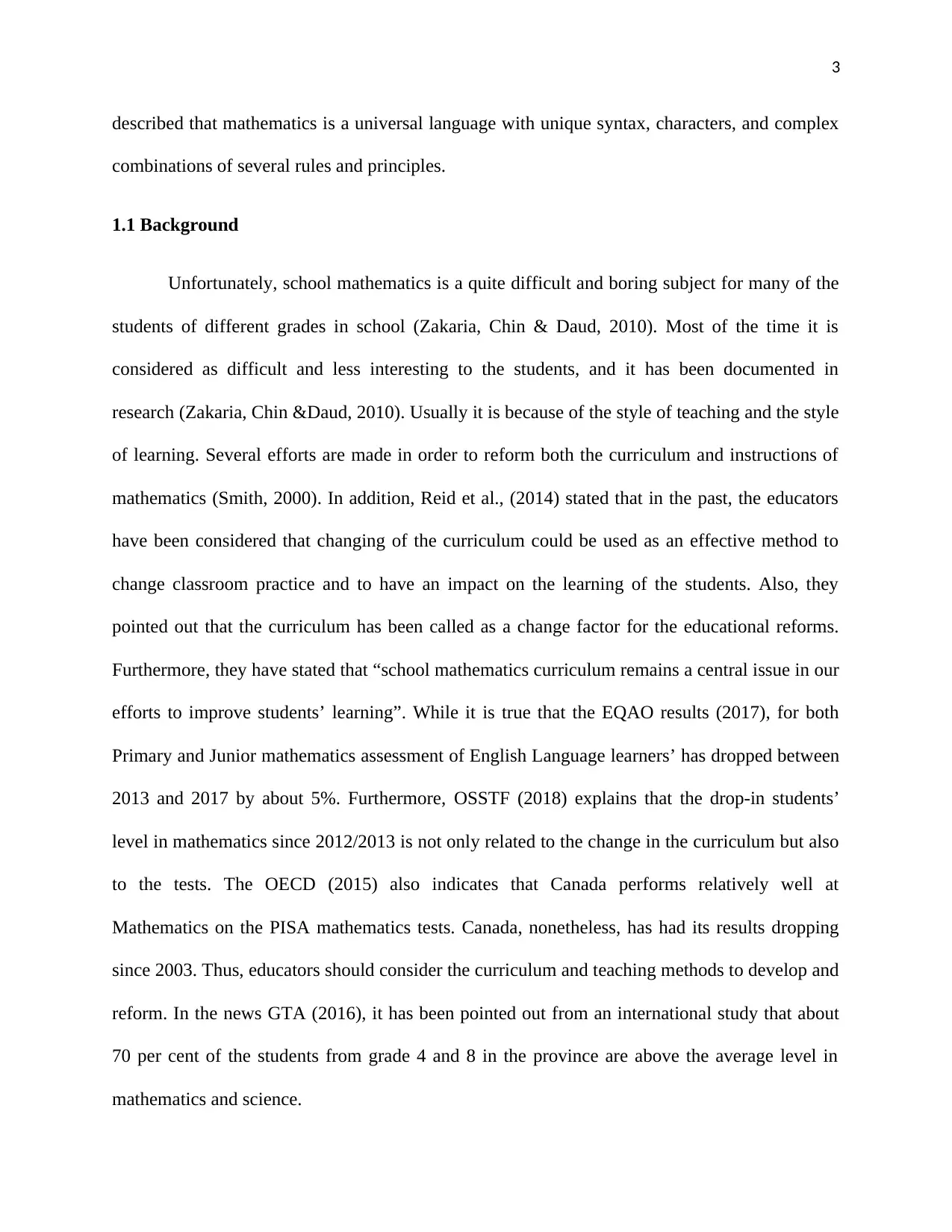
3
described that mathematics is a universal language with unique syntax, characters, and complex
combinations of several rules and principles.
1.1 Background
Unfortunately, school mathematics is a quite difficult and boring subject for many of the
students of different grades in school (Zakaria, Chin & Daud, 2010). Most of the time it is
considered as difficult and less interesting to the students, and it has been documented in
research (Zakaria, Chin &Daud, 2010). Usually it is because of the style of teaching and the style
of learning. Several efforts are made in order to reform both the curriculum and instructions of
mathematics (Smith, 2000). In addition, Reid et al., (2014) stated that in the past, the educators
have been considered that changing of the curriculum could be used as an effective method to
change classroom practice and to have an impact on the learning of the students. Also, they
pointed out that the curriculum has been called as a change factor for the educational reforms.
Furthermore, they have stated that “school mathematics curriculum remains a central issue in our
efforts to improve students’ learning”. While it is true that the EQAO results (2017), for both
Primary and Junior mathematics assessment of English Language learners’ has dropped between
2013 and 2017 by about 5%. Furthermore, OSSTF (2018) explains that the drop-in students’
level in mathematics since 2012/2013 is not only related to the change in the curriculum but also
to the tests. The OECD (2015) also indicates that Canada performs relatively well at
Mathematics on the PISA mathematics tests. Canada, nonetheless, has had its results dropping
since 2003. Thus, educators should consider the curriculum and teaching methods to develop and
reform. In the news GTA (2016), it has been pointed out from an international study that about
70 per cent of the students from grade 4 and 8 in the province are above the average level in
mathematics and science.
described that mathematics is a universal language with unique syntax, characters, and complex
combinations of several rules and principles.
1.1 Background
Unfortunately, school mathematics is a quite difficult and boring subject for many of the
students of different grades in school (Zakaria, Chin & Daud, 2010). Most of the time it is
considered as difficult and less interesting to the students, and it has been documented in
research (Zakaria, Chin &Daud, 2010). Usually it is because of the style of teaching and the style
of learning. Several efforts are made in order to reform both the curriculum and instructions of
mathematics (Smith, 2000). In addition, Reid et al., (2014) stated that in the past, the educators
have been considered that changing of the curriculum could be used as an effective method to
change classroom practice and to have an impact on the learning of the students. Also, they
pointed out that the curriculum has been called as a change factor for the educational reforms.
Furthermore, they have stated that “school mathematics curriculum remains a central issue in our
efforts to improve students’ learning”. While it is true that the EQAO results (2017), for both
Primary and Junior mathematics assessment of English Language learners’ has dropped between
2013 and 2017 by about 5%. Furthermore, OSSTF (2018) explains that the drop-in students’
level in mathematics since 2012/2013 is not only related to the change in the curriculum but also
to the tests. The OECD (2015) also indicates that Canada performs relatively well at
Mathematics on the PISA mathematics tests. Canada, nonetheless, has had its results dropping
since 2003. Thus, educators should consider the curriculum and teaching methods to develop and
reform. In the news GTA (2016), it has been pointed out from an international study that about
70 per cent of the students from grade 4 and 8 in the province are above the average level in
mathematics and science.
⊘ This is a preview!⊘
Do you want full access?
Subscribe today to unlock all pages.

Trusted by 1+ million students worldwide
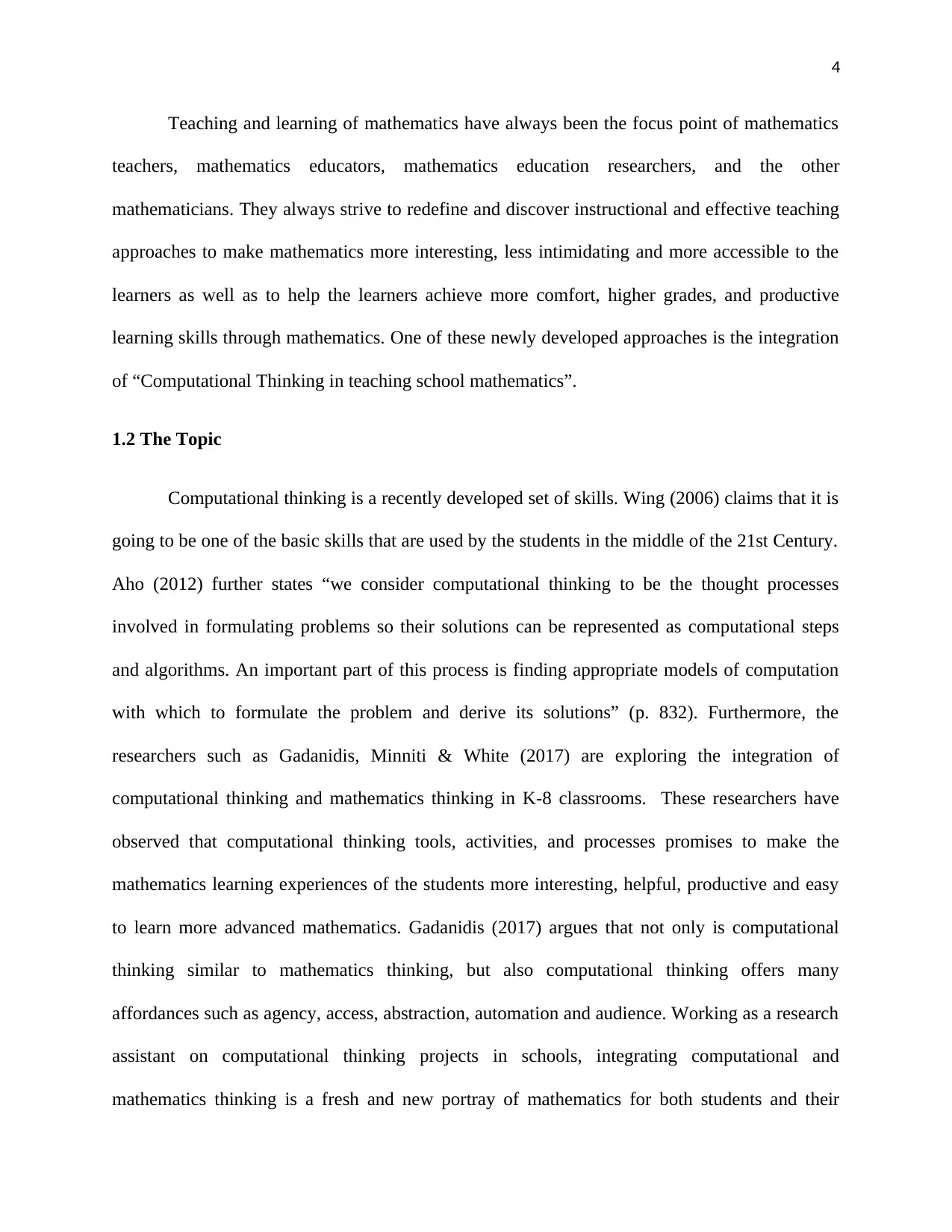
4
Teaching and learning of mathematics have always been the focus point of mathematics
teachers, mathematics educators, mathematics education researchers, and the other
mathematicians. They always strive to redefine and discover instructional and effective teaching
approaches to make mathematics more interesting, less intimidating and more accessible to the
learners as well as to help the learners achieve more comfort, higher grades, and productive
learning skills through mathematics. One of these newly developed approaches is the integration
of “Computational Thinking in teaching school mathematics”.
1.2 The Topic
Computational thinking is a recently developed set of skills. Wing (2006) claims that it is
going to be one of the basic skills that are used by the students in the middle of the 21st Century.
Aho (2012) further states “we consider computational thinking to be the thought processes
involved in formulating problems so their solutions can be represented as computational steps
and algorithms. An important part of this process is finding appropriate models of computation
with which to formulate the problem and derive its solutions” (p. 832). Furthermore, the
researchers such as Gadanidis, Minniti & White (2017) are exploring the integration of
computational thinking and mathematics thinking in K-8 classrooms. These researchers have
observed that computational thinking tools, activities, and processes promises to make the
mathematics learning experiences of the students more interesting, helpful, productive and easy
to learn more advanced mathematics. Gadanidis (2017) argues that not only is computational
thinking similar to mathematics thinking, but also computational thinking offers many
affordances such as agency, access, abstraction, automation and audience. Working as a research
assistant on computational thinking projects in schools, integrating computational and
mathematics thinking is a fresh and new portray of mathematics for both students and their
Teaching and learning of mathematics have always been the focus point of mathematics
teachers, mathematics educators, mathematics education researchers, and the other
mathematicians. They always strive to redefine and discover instructional and effective teaching
approaches to make mathematics more interesting, less intimidating and more accessible to the
learners as well as to help the learners achieve more comfort, higher grades, and productive
learning skills through mathematics. One of these newly developed approaches is the integration
of “Computational Thinking in teaching school mathematics”.
1.2 The Topic
Computational thinking is a recently developed set of skills. Wing (2006) claims that it is
going to be one of the basic skills that are used by the students in the middle of the 21st Century.
Aho (2012) further states “we consider computational thinking to be the thought processes
involved in formulating problems so their solutions can be represented as computational steps
and algorithms. An important part of this process is finding appropriate models of computation
with which to formulate the problem and derive its solutions” (p. 832). Furthermore, the
researchers such as Gadanidis, Minniti & White (2017) are exploring the integration of
computational thinking and mathematics thinking in K-8 classrooms. These researchers have
observed that computational thinking tools, activities, and processes promises to make the
mathematics learning experiences of the students more interesting, helpful, productive and easy
to learn more advanced mathematics. Gadanidis (2017) argues that not only is computational
thinking similar to mathematics thinking, but also computational thinking offers many
affordances such as agency, access, abstraction, automation and audience. Working as a research
assistant on computational thinking projects in schools, integrating computational and
mathematics thinking is a fresh and new portray of mathematics for both students and their
Paraphrase This Document
Need a fresh take? Get an instant paraphrase of this document with our AI Paraphraser
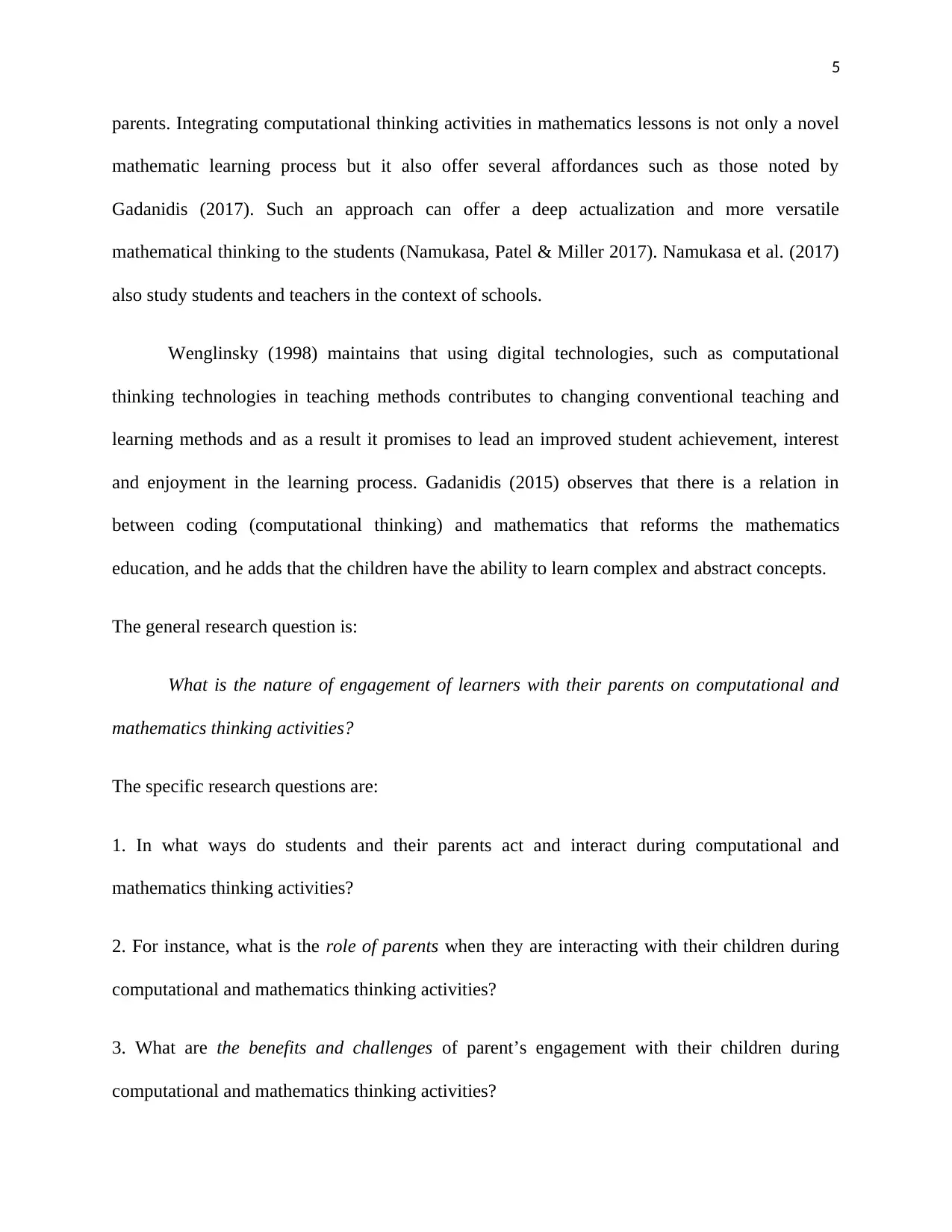
5
parents. Integrating computational thinking activities in mathematics lessons is not only a novel
mathematic learning process but it also offer several affordances such as those noted by
Gadanidis (2017). Such an approach can offer a deep actualization and more versatile
mathematical thinking to the students (Namukasa, Patel & Miller 2017). Namukasa et al. (2017)
also study students and teachers in the context of schools.
Wenglinsky (1998) maintains that using digital technologies, such as computational
thinking technologies in teaching methods contributes to changing conventional teaching and
learning methods and as a result it promises to lead an improved student achievement, interest
and enjoyment in the learning process. Gadanidis (2015) observes that there is a relation in
between coding (computational thinking) and mathematics that reforms the mathematics
education, and he adds that the children have the ability to learn complex and abstract concepts.
The general research question is:
What is the nature of engagement of learners with their parents on computational and
mathematics thinking activities?
The specific research questions are:
1. In what ways do students and their parents act and interact during computational and
mathematics thinking activities?
2. For instance, what is the role of parents when they are interacting with their children during
computational and mathematics thinking activities?
3. What are the benefits and challenges of parent’s engagement with their children during
computational and mathematics thinking activities?
parents. Integrating computational thinking activities in mathematics lessons is not only a novel
mathematic learning process but it also offer several affordances such as those noted by
Gadanidis (2017). Such an approach can offer a deep actualization and more versatile
mathematical thinking to the students (Namukasa, Patel & Miller 2017). Namukasa et al. (2017)
also study students and teachers in the context of schools.
Wenglinsky (1998) maintains that using digital technologies, such as computational
thinking technologies in teaching methods contributes to changing conventional teaching and
learning methods and as a result it promises to lead an improved student achievement, interest
and enjoyment in the learning process. Gadanidis (2015) observes that there is a relation in
between coding (computational thinking) and mathematics that reforms the mathematics
education, and he adds that the children have the ability to learn complex and abstract concepts.
The general research question is:
What is the nature of engagement of learners with their parents on computational and
mathematics thinking activities?
The specific research questions are:
1. In what ways do students and their parents act and interact during computational and
mathematics thinking activities?
2. For instance, what is the role of parents when they are interacting with their children during
computational and mathematics thinking activities?
3. What are the benefits and challenges of parent’s engagement with their children during
computational and mathematics thinking activities?
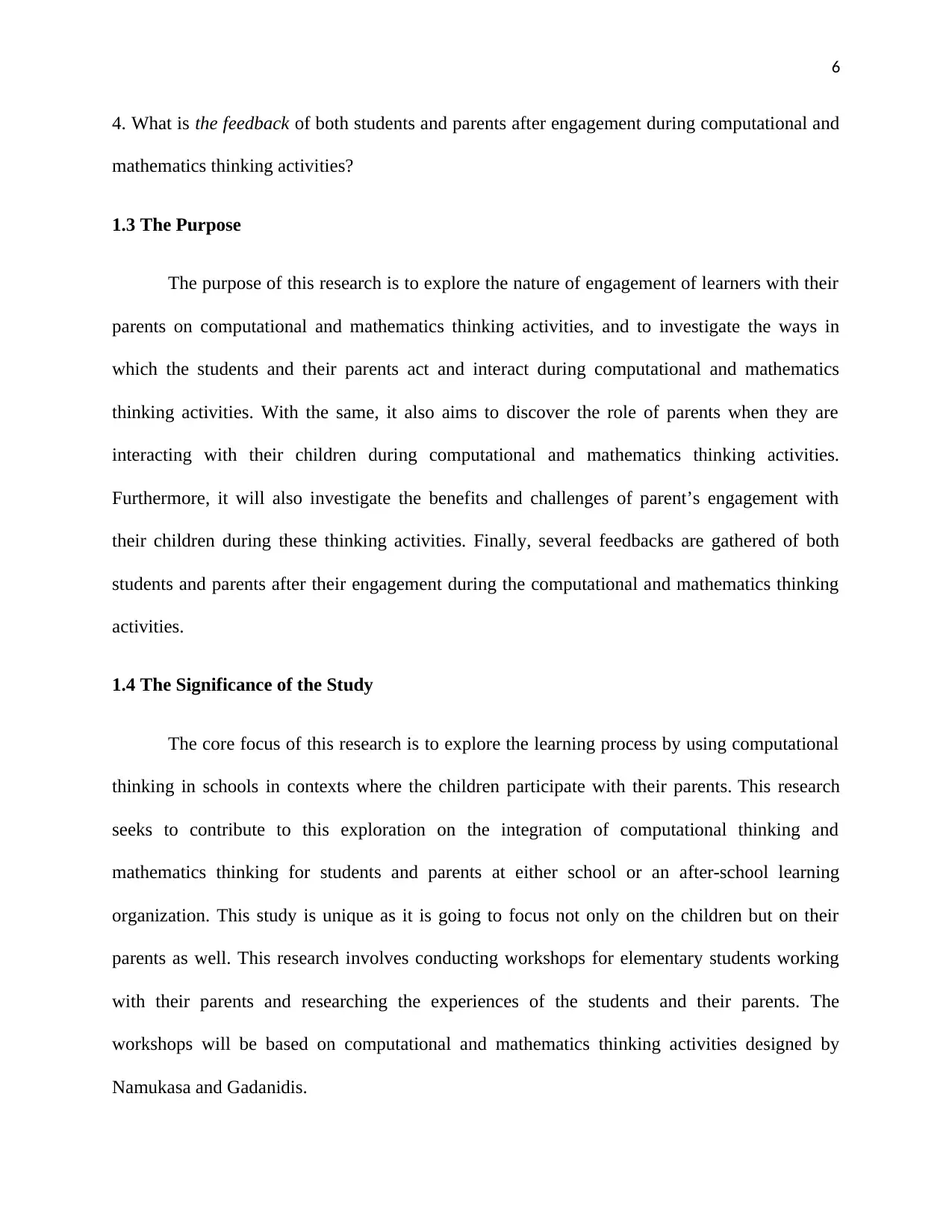
6
4. What is the feedback of both students and parents after engagement during computational and
mathematics thinking activities?
1.3 The Purpose
The purpose of this research is to explore the nature of engagement of learners with their
parents on computational and mathematics thinking activities, and to investigate the ways in
which the students and their parents act and interact during computational and mathematics
thinking activities. With the same, it also aims to discover the role of parents when they are
interacting with their children during computational and mathematics thinking activities.
Furthermore, it will also investigate the benefits and challenges of parent’s engagement with
their children during these thinking activities. Finally, several feedbacks are gathered of both
students and parents after their engagement during the computational and mathematics thinking
activities.
1.4 The Significance of the Study
The core focus of this research is to explore the learning process by using computational
thinking in schools in contexts where the children participate with their parents. This research
seeks to contribute to this exploration on the integration of computational thinking and
mathematics thinking for students and parents at either school or an after-school learning
organization. This study is unique as it is going to focus not only on the children but on their
parents as well. This research involves conducting workshops for elementary students working
with their parents and researching the experiences of the students and their parents. The
workshops will be based on computational and mathematics thinking activities designed by
Namukasa and Gadanidis.
4. What is the feedback of both students and parents after engagement during computational and
mathematics thinking activities?
1.3 The Purpose
The purpose of this research is to explore the nature of engagement of learners with their
parents on computational and mathematics thinking activities, and to investigate the ways in
which the students and their parents act and interact during computational and mathematics
thinking activities. With the same, it also aims to discover the role of parents when they are
interacting with their children during computational and mathematics thinking activities.
Furthermore, it will also investigate the benefits and challenges of parent’s engagement with
their children during these thinking activities. Finally, several feedbacks are gathered of both
students and parents after their engagement during the computational and mathematics thinking
activities.
1.4 The Significance of the Study
The core focus of this research is to explore the learning process by using computational
thinking in schools in contexts where the children participate with their parents. This research
seeks to contribute to this exploration on the integration of computational thinking and
mathematics thinking for students and parents at either school or an after-school learning
organization. This study is unique as it is going to focus not only on the children but on their
parents as well. This research involves conducting workshops for elementary students working
with their parents and researching the experiences of the students and their parents. The
workshops will be based on computational and mathematics thinking activities designed by
Namukasa and Gadanidis.
⊘ This is a preview!⊘
Do you want full access?
Subscribe today to unlock all pages.

Trusted by 1+ million students worldwide
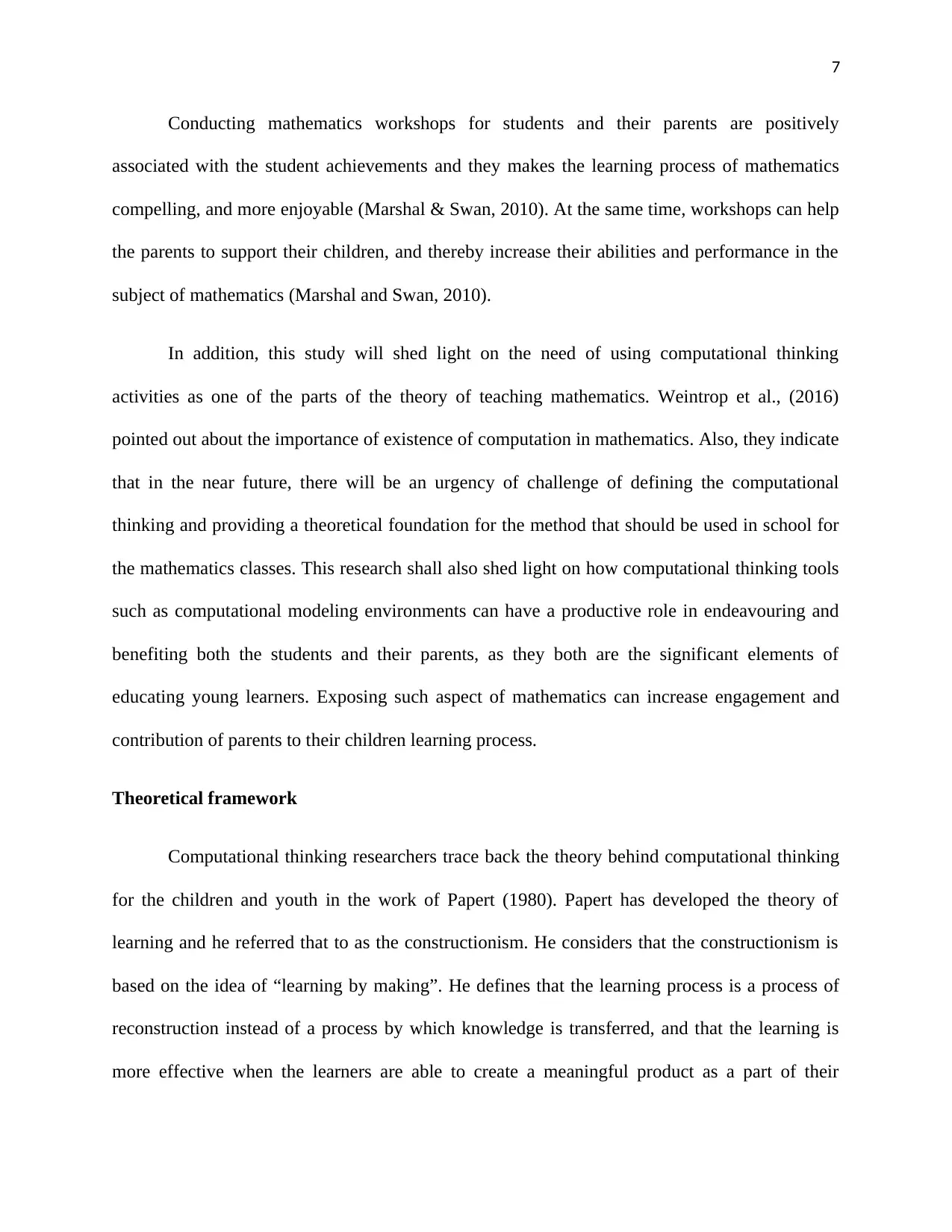
7
Conducting mathematics workshops for students and their parents are positively
associated with the student achievements and they makes the learning process of mathematics
compelling, and more enjoyable (Marshal & Swan, 2010). At the same time, workshops can help
the parents to support their children, and thereby increase their abilities and performance in the
subject of mathematics (Marshal and Swan, 2010).
In addition, this study will shed light on the need of using computational thinking
activities as one of the parts of the theory of teaching mathematics. Weintrop et al., (2016)
pointed out about the importance of existence of computation in mathematics. Also, they indicate
that in the near future, there will be an urgency of challenge of defining the computational
thinking and providing a theoretical foundation for the method that should be used in school for
the mathematics classes. This research shall also shed light on how computational thinking tools
such as computational modeling environments can have a productive role in endeavouring and
benefiting both the students and their parents, as they both are the significant elements of
educating young learners. Exposing such aspect of mathematics can increase engagement and
contribution of parents to their children learning process.
Theoretical framework
Computational thinking researchers trace back the theory behind computational thinking
for the children and youth in the work of Papert (1980). Papert has developed the theory of
learning and he referred that to as the constructionism. He considers that the constructionism is
based on the idea of “learning by making”. He defines that the learning process is a process of
reconstruction instead of a process by which knowledge is transferred, and that the learning is
more effective when the learners are able to create a meaningful product as a part of their
Conducting mathematics workshops for students and their parents are positively
associated with the student achievements and they makes the learning process of mathematics
compelling, and more enjoyable (Marshal & Swan, 2010). At the same time, workshops can help
the parents to support their children, and thereby increase their abilities and performance in the
subject of mathematics (Marshal and Swan, 2010).
In addition, this study will shed light on the need of using computational thinking
activities as one of the parts of the theory of teaching mathematics. Weintrop et al., (2016)
pointed out about the importance of existence of computation in mathematics. Also, they indicate
that in the near future, there will be an urgency of challenge of defining the computational
thinking and providing a theoretical foundation for the method that should be used in school for
the mathematics classes. This research shall also shed light on how computational thinking tools
such as computational modeling environments can have a productive role in endeavouring and
benefiting both the students and their parents, as they both are the significant elements of
educating young learners. Exposing such aspect of mathematics can increase engagement and
contribution of parents to their children learning process.
Theoretical framework
Computational thinking researchers trace back the theory behind computational thinking
for the children and youth in the work of Papert (1980). Papert has developed the theory of
learning and he referred that to as the constructionism. He considers that the constructionism is
based on the idea of “learning by making”. He defines that the learning process is a process of
reconstruction instead of a process by which knowledge is transferred, and that the learning is
more effective when the learners are able to create a meaningful product as a part of their
Paraphrase This Document
Need a fresh take? Get an instant paraphrase of this document with our AI Paraphraser
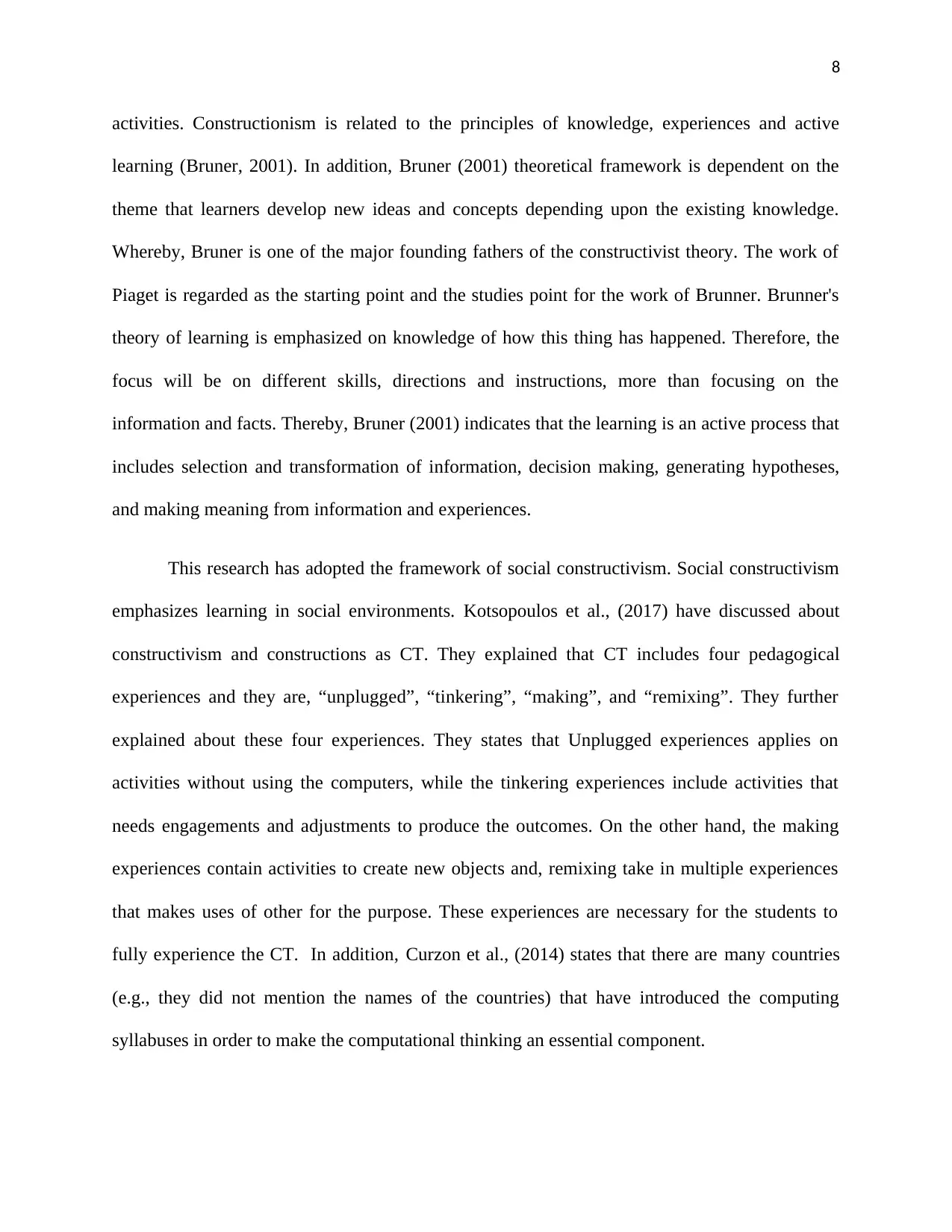
8
activities. Constructionism is related to the principles of knowledge, experiences and active
learning (Bruner, 2001). In addition, Bruner (2001) theoretical framework is dependent on the
theme that learners develop new ideas and concepts depending upon the existing knowledge.
Whereby, Bruner is one of the major founding fathers of the constructivist theory. The work of
Piaget is regarded as the starting point and the studies point for the work of Brunner. Brunner's
theory of learning is emphasized on knowledge of how this thing has happened. Therefore, the
focus will be on different skills, directions and instructions, more than focusing on the
information and facts. Thereby, Bruner (2001) indicates that the learning is an active process that
includes selection and transformation of information, decision making, generating hypotheses,
and making meaning from information and experiences.
This research has adopted the framework of social constructivism. Social constructivism
emphasizes learning in social environments. Kotsopoulos et al., (2017) have discussed about
constructivism and constructions as CT. They explained that CT includes four pedagogical
experiences and they are, “unplugged”, “tinkering”, “making”, and “remixing”. They further
explained about these four experiences. They states that Unplugged experiences applies on
activities without using the computers, while the tinkering experiences include activities that
needs engagements and adjustments to produce the outcomes. On the other hand, the making
experiences contain activities to create new objects and, remixing take in multiple experiences
that makes uses of other for the purpose. These experiences are necessary for the students to
fully experience the CT. In addition, Curzon et al., (2014) states that there are many countries
(e.g., they did not mention the names of the countries) that have introduced the computing
syllabuses in order to make the computational thinking an essential component.
activities. Constructionism is related to the principles of knowledge, experiences and active
learning (Bruner, 2001). In addition, Bruner (2001) theoretical framework is dependent on the
theme that learners develop new ideas and concepts depending upon the existing knowledge.
Whereby, Bruner is one of the major founding fathers of the constructivist theory. The work of
Piaget is regarded as the starting point and the studies point for the work of Brunner. Brunner's
theory of learning is emphasized on knowledge of how this thing has happened. Therefore, the
focus will be on different skills, directions and instructions, more than focusing on the
information and facts. Thereby, Bruner (2001) indicates that the learning is an active process that
includes selection and transformation of information, decision making, generating hypotheses,
and making meaning from information and experiences.
This research has adopted the framework of social constructivism. Social constructivism
emphasizes learning in social environments. Kotsopoulos et al., (2017) have discussed about
constructivism and constructions as CT. They explained that CT includes four pedagogical
experiences and they are, “unplugged”, “tinkering”, “making”, and “remixing”. They further
explained about these four experiences. They states that Unplugged experiences applies on
activities without using the computers, while the tinkering experiences include activities that
needs engagements and adjustments to produce the outcomes. On the other hand, the making
experiences contain activities to create new objects and, remixing take in multiple experiences
that makes uses of other for the purpose. These experiences are necessary for the students to
fully experience the CT. In addition, Curzon et al., (2014) states that there are many countries
(e.g., they did not mention the names of the countries) that have introduced the computing
syllabuses in order to make the computational thinking an essential component.
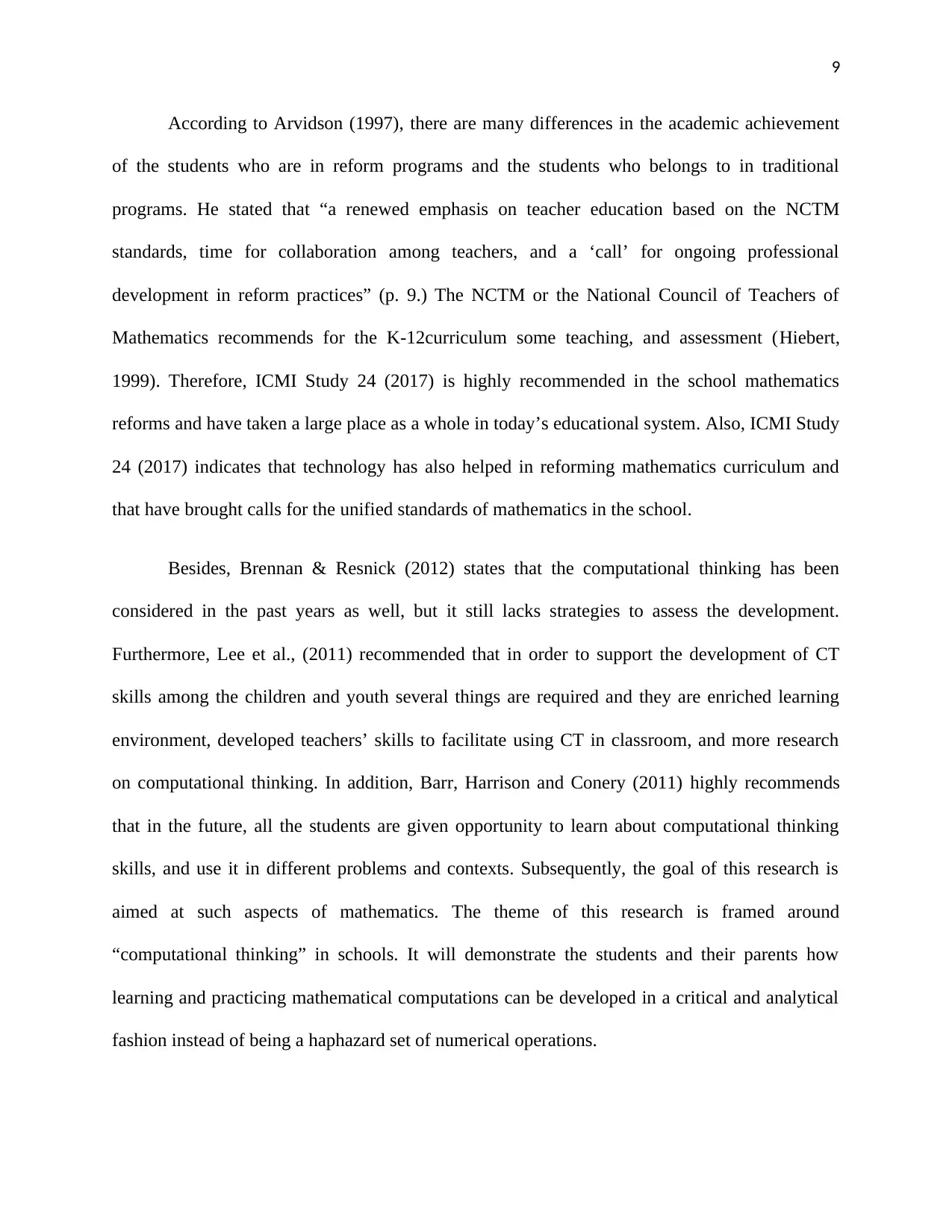
9
According to Arvidson (1997), there are many differences in the academic achievement
of the students who are in reform programs and the students who belongs to in traditional
programs. He stated that “a renewed emphasis on teacher education based on the NCTM
standards, time for collaboration among teachers, and a ‘call’ for ongoing professional
development in reform practices” (p. 9.) The NCTM or the National Council of Teachers of
Mathematics recommends for the K-12curriculum some teaching, and assessment (Hiebert,
1999). Therefore, ICMI Study 24 (2017) is highly recommended in the school mathematics
reforms and have taken a large place as a whole in today’s educational system. Also, ICMI Study
24 (2017) indicates that technology has also helped in reforming mathematics curriculum and
that have brought calls for the unified standards of mathematics in the school.
Besides, Brennan & Resnick (2012) states that the computational thinking has been
considered in the past years as well, but it still lacks strategies to assess the development.
Furthermore, Lee et al., (2011) recommended that in order to support the development of CT
skills among the children and youth several things are required and they are enriched learning
environment, developed teachers’ skills to facilitate using CT in classroom, and more research
on computational thinking. In addition, Barr, Harrison and Conery (2011) highly recommends
that in the future, all the students are given opportunity to learn about computational thinking
skills, and use it in different problems and contexts. Subsequently, the goal of this research is
aimed at such aspects of mathematics. The theme of this research is framed around
“computational thinking” in schools. It will demonstrate the students and their parents how
learning and practicing mathematical computations can be developed in a critical and analytical
fashion instead of being a haphazard set of numerical operations.
According to Arvidson (1997), there are many differences in the academic achievement
of the students who are in reform programs and the students who belongs to in traditional
programs. He stated that “a renewed emphasis on teacher education based on the NCTM
standards, time for collaboration among teachers, and a ‘call’ for ongoing professional
development in reform practices” (p. 9.) The NCTM or the National Council of Teachers of
Mathematics recommends for the K-12curriculum some teaching, and assessment (Hiebert,
1999). Therefore, ICMI Study 24 (2017) is highly recommended in the school mathematics
reforms and have taken a large place as a whole in today’s educational system. Also, ICMI Study
24 (2017) indicates that technology has also helped in reforming mathematics curriculum and
that have brought calls for the unified standards of mathematics in the school.
Besides, Brennan & Resnick (2012) states that the computational thinking has been
considered in the past years as well, but it still lacks strategies to assess the development.
Furthermore, Lee et al., (2011) recommended that in order to support the development of CT
skills among the children and youth several things are required and they are enriched learning
environment, developed teachers’ skills to facilitate using CT in classroom, and more research
on computational thinking. In addition, Barr, Harrison and Conery (2011) highly recommends
that in the future, all the students are given opportunity to learn about computational thinking
skills, and use it in different problems and contexts. Subsequently, the goal of this research is
aimed at such aspects of mathematics. The theme of this research is framed around
“computational thinking” in schools. It will demonstrate the students and their parents how
learning and practicing mathematical computations can be developed in a critical and analytical
fashion instead of being a haphazard set of numerical operations.
⊘ This is a preview!⊘
Do you want full access?
Subscribe today to unlock all pages.

Trusted by 1+ million students worldwide
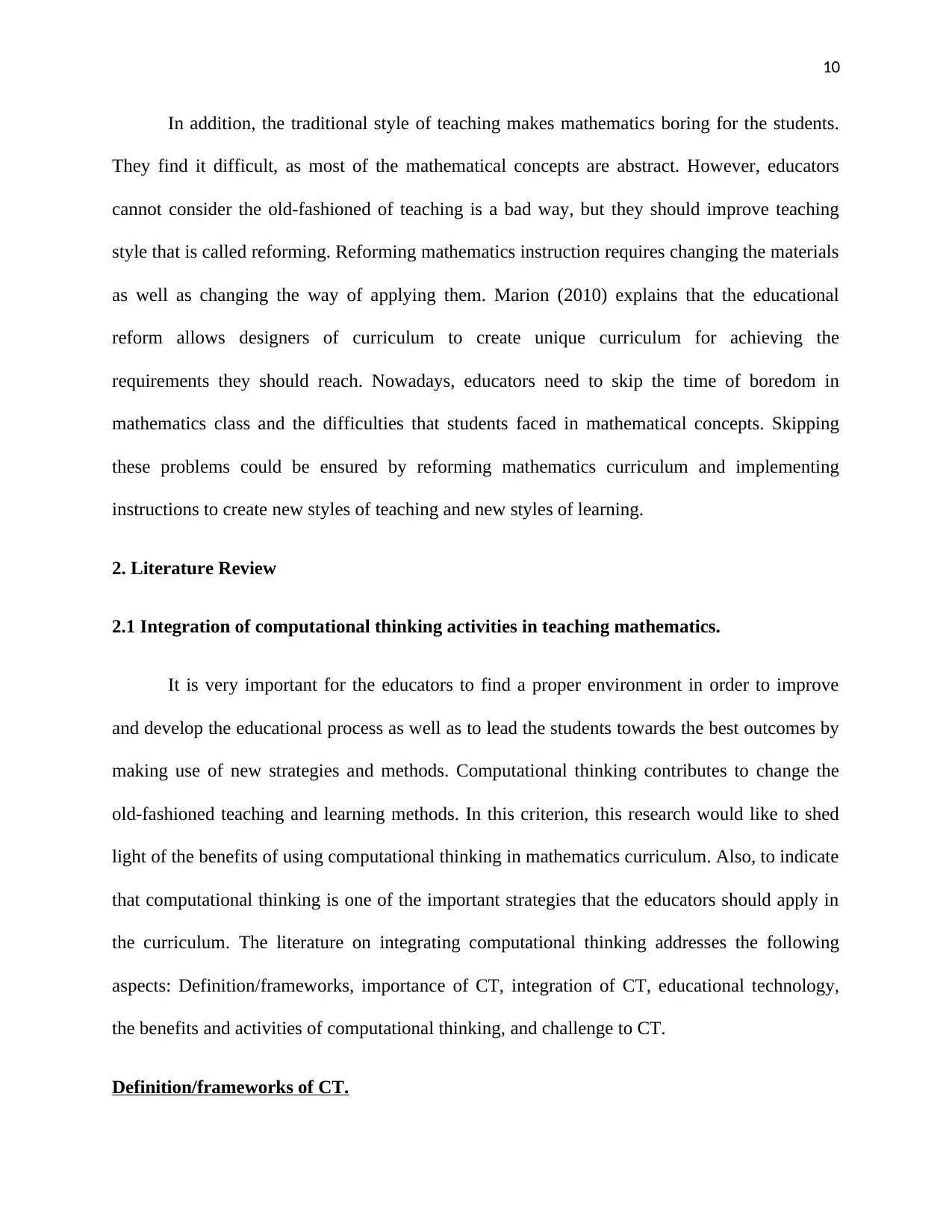
10
In addition, the traditional style of teaching makes mathematics boring for the students.
They find it difficult, as most of the mathematical concepts are abstract. However, educators
cannot consider the old-fashioned of teaching is a bad way, but they should improve teaching
style that is called reforming. Reforming mathematics instruction requires changing the materials
as well as changing the way of applying them. Marion (2010) explains that the educational
reform allows designers of curriculum to create unique curriculum for achieving the
requirements they should reach. Nowadays, educators need to skip the time of boredom in
mathematics class and the difficulties that students faced in mathematical concepts. Skipping
these problems could be ensured by reforming mathematics curriculum and implementing
instructions to create new styles of teaching and new styles of learning.
2. Literature Review
2.1 Integration of computational thinking activities in teaching mathematics.
It is very important for the educators to find a proper environment in order to improve
and develop the educational process as well as to lead the students towards the best outcomes by
making use of new strategies and methods. Computational thinking contributes to change the
old-fashioned teaching and learning methods. In this criterion, this research would like to shed
light of the benefits of using computational thinking in mathematics curriculum. Also, to indicate
that computational thinking is one of the important strategies that the educators should apply in
the curriculum. The literature on integrating computational thinking addresses the following
aspects: Definition/frameworks, importance of CT, integration of CT, educational technology,
the benefits and activities of computational thinking, and challenge to CT.
Definition/frameworks of CT.
In addition, the traditional style of teaching makes mathematics boring for the students.
They find it difficult, as most of the mathematical concepts are abstract. However, educators
cannot consider the old-fashioned of teaching is a bad way, but they should improve teaching
style that is called reforming. Reforming mathematics instruction requires changing the materials
as well as changing the way of applying them. Marion (2010) explains that the educational
reform allows designers of curriculum to create unique curriculum for achieving the
requirements they should reach. Nowadays, educators need to skip the time of boredom in
mathematics class and the difficulties that students faced in mathematical concepts. Skipping
these problems could be ensured by reforming mathematics curriculum and implementing
instructions to create new styles of teaching and new styles of learning.
2. Literature Review
2.1 Integration of computational thinking activities in teaching mathematics.
It is very important for the educators to find a proper environment in order to improve
and develop the educational process as well as to lead the students towards the best outcomes by
making use of new strategies and methods. Computational thinking contributes to change the
old-fashioned teaching and learning methods. In this criterion, this research would like to shed
light of the benefits of using computational thinking in mathematics curriculum. Also, to indicate
that computational thinking is one of the important strategies that the educators should apply in
the curriculum. The literature on integrating computational thinking addresses the following
aspects: Definition/frameworks, importance of CT, integration of CT, educational technology,
the benefits and activities of computational thinking, and challenge to CT.
Definition/frameworks of CT.
Paraphrase This Document
Need a fresh take? Get an instant paraphrase of this document with our AI Paraphraser
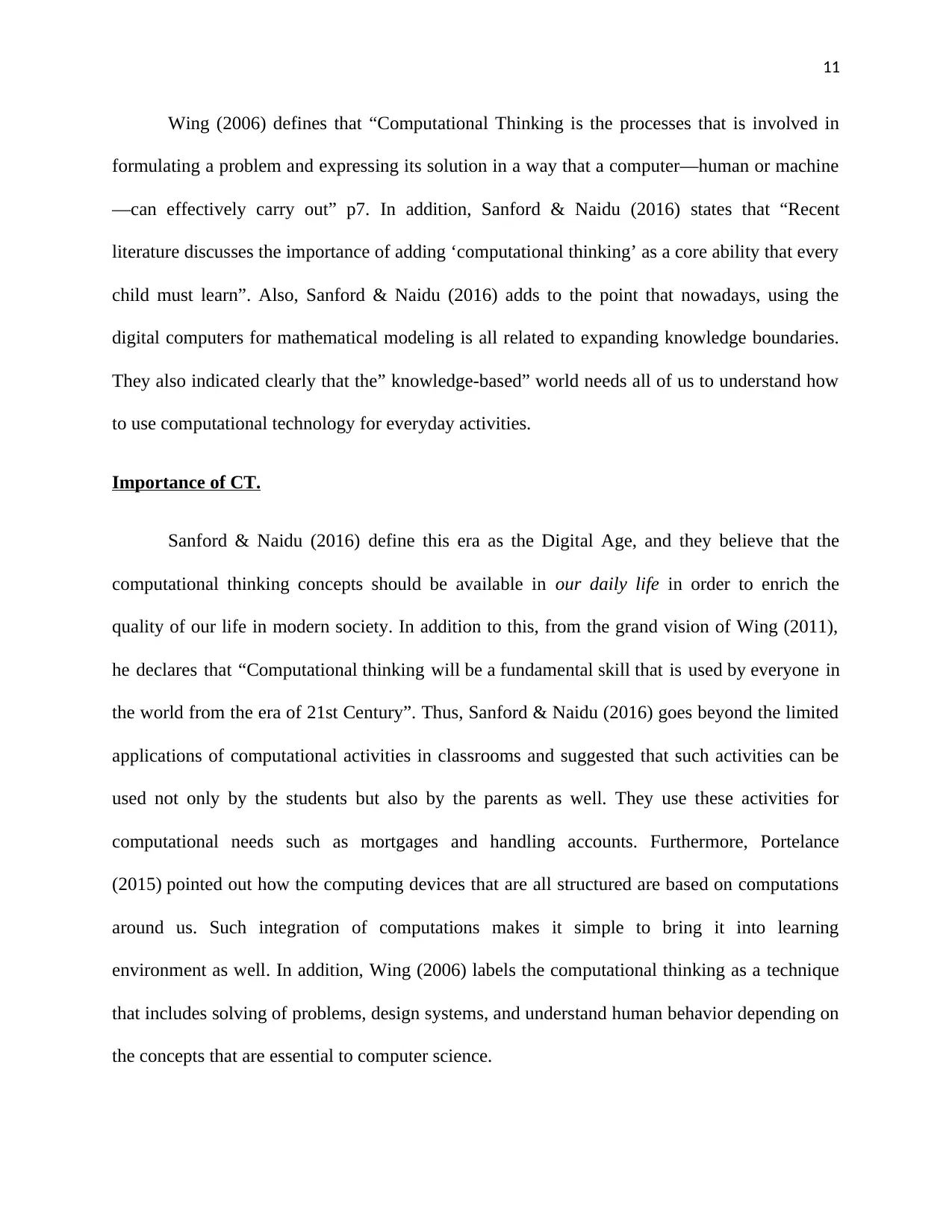
11
Wing (2006) defines that “Computational Thinking is the processes that is involved in
formulating a problem and expressing its solution in a way that a computer—human or machine
—can effectively carry out” p7. In addition, Sanford & Naidu (2016) states that “Recent
literature discusses the importance of adding ‘computational thinking’ as a core ability that every
child must learn”. Also, Sanford & Naidu (2016) adds to the point that nowadays, using the
digital computers for mathematical modeling is all related to expanding knowledge boundaries.
They also indicated clearly that the” knowledge-based” world needs all of us to understand how
to use computational technology for everyday activities.
Importance of CT.
Sanford & Naidu (2016) define this era as the Digital Age, and they believe that the
computational thinking concepts should be available in our daily life in order to enrich the
quality of our life in modern society. In addition to this, from the grand vision of Wing (2011),
he declares that “Computational thinking will be a fundamental skill that is used by everyone in
the world from the era of 21st Century”. Thus, Sanford & Naidu (2016) goes beyond the limited
applications of computational activities in classrooms and suggested that such activities can be
used not only by the students but also by the parents as well. They use these activities for
computational needs such as mortgages and handling accounts. Furthermore, Portelance
(2015) pointed out how the computing devices that are all structured are based on computations
around us. Such integration of computations makes it simple to bring it into learning
environment as well. In addition, Wing (2006) labels the computational thinking as a technique
that includes solving of problems, design systems, and understand human behavior depending on
the concepts that are essential to computer science.
Wing (2006) defines that “Computational Thinking is the processes that is involved in
formulating a problem and expressing its solution in a way that a computer—human or machine
—can effectively carry out” p7. In addition, Sanford & Naidu (2016) states that “Recent
literature discusses the importance of adding ‘computational thinking’ as a core ability that every
child must learn”. Also, Sanford & Naidu (2016) adds to the point that nowadays, using the
digital computers for mathematical modeling is all related to expanding knowledge boundaries.
They also indicated clearly that the” knowledge-based” world needs all of us to understand how
to use computational technology for everyday activities.
Importance of CT.
Sanford & Naidu (2016) define this era as the Digital Age, and they believe that the
computational thinking concepts should be available in our daily life in order to enrich the
quality of our life in modern society. In addition to this, from the grand vision of Wing (2011),
he declares that “Computational thinking will be a fundamental skill that is used by everyone in
the world from the era of 21st Century”. Thus, Sanford & Naidu (2016) goes beyond the limited
applications of computational activities in classrooms and suggested that such activities can be
used not only by the students but also by the parents as well. They use these activities for
computational needs such as mortgages and handling accounts. Furthermore, Portelance
(2015) pointed out how the computing devices that are all structured are based on computations
around us. Such integration of computations makes it simple to bring it into learning
environment as well. In addition, Wing (2006) labels the computational thinking as a technique
that includes solving of problems, design systems, and understand human behavior depending on
the concepts that are essential to computer science.
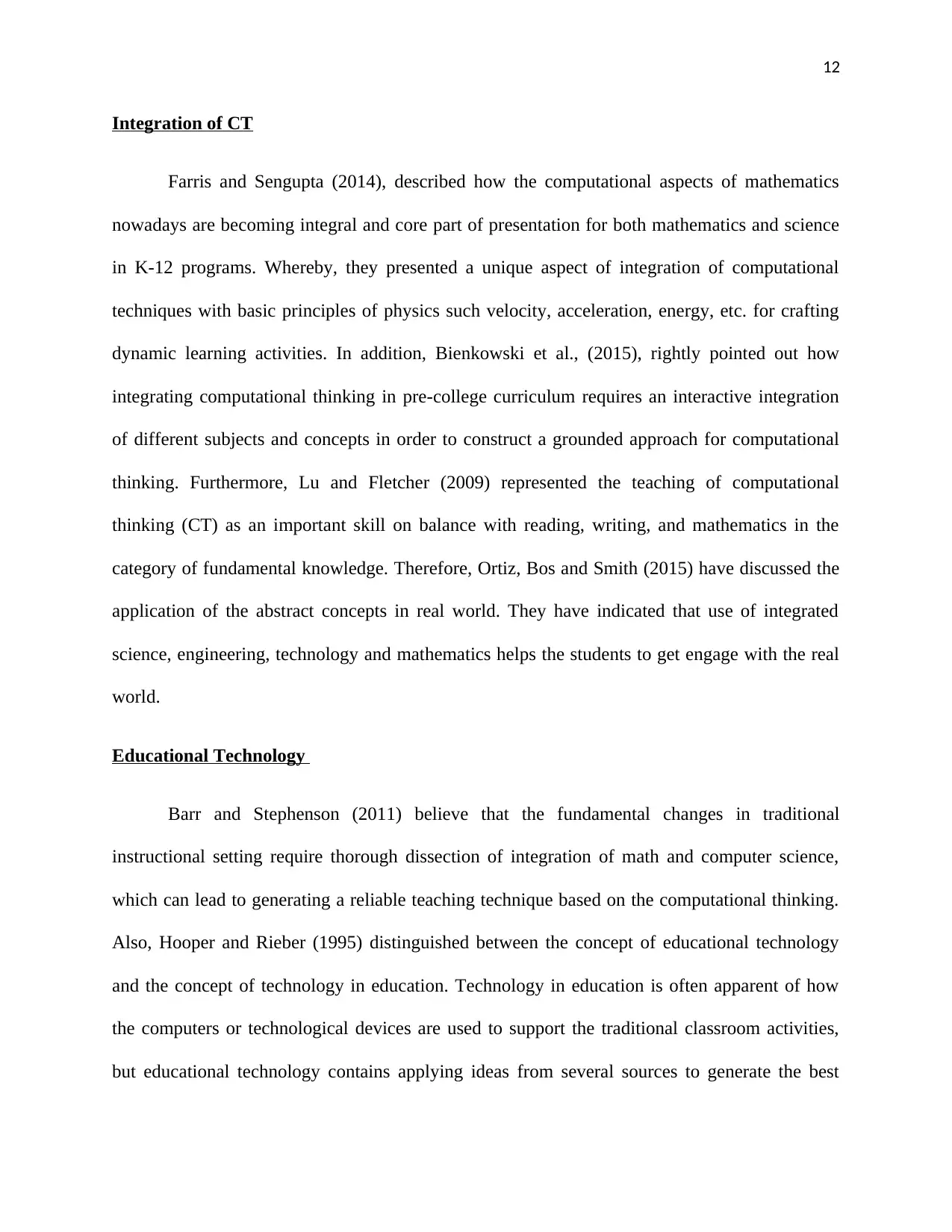
12
Integration of CT
Farris and Sengupta (2014), described how the computational aspects of mathematics
nowadays are becoming integral and core part of presentation for both mathematics and science
in K-12 programs. Whereby, they presented a unique aspect of integration of computational
techniques with basic principles of physics such velocity, acceleration, energy, etc. for crafting
dynamic learning activities. In addition, Bienkowski et al., (2015), rightly pointed out how
integrating computational thinking in pre-college curriculum requires an interactive integration
of different subjects and concepts in order to construct a grounded approach for computational
thinking. Furthermore, Lu and Fletcher (2009) represented the teaching of computational
thinking (CT) as an important skill on balance with reading, writing, and mathematics in the
category of fundamental knowledge. Therefore, Ortiz, Bos and Smith (2015) have discussed the
application of the abstract concepts in real world. They have indicated that use of integrated
science, engineering, technology and mathematics helps the students to get engage with the real
world.
Educational Technology
Barr and Stephenson (2011) believe that the fundamental changes in traditional
instructional setting require thorough dissection of integration of math and computer science,
which can lead to generating a reliable teaching technique based on the computational thinking.
Also, Hooper and Rieber (1995) distinguished between the concept of educational technology
and the concept of technology in education. Technology in education is often apparent of how
the computers or technological devices are used to support the traditional classroom activities,
but educational technology contains applying ideas from several sources to generate the best
Integration of CT
Farris and Sengupta (2014), described how the computational aspects of mathematics
nowadays are becoming integral and core part of presentation for both mathematics and science
in K-12 programs. Whereby, they presented a unique aspect of integration of computational
techniques with basic principles of physics such velocity, acceleration, energy, etc. for crafting
dynamic learning activities. In addition, Bienkowski et al., (2015), rightly pointed out how
integrating computational thinking in pre-college curriculum requires an interactive integration
of different subjects and concepts in order to construct a grounded approach for computational
thinking. Furthermore, Lu and Fletcher (2009) represented the teaching of computational
thinking (CT) as an important skill on balance with reading, writing, and mathematics in the
category of fundamental knowledge. Therefore, Ortiz, Bos and Smith (2015) have discussed the
application of the abstract concepts in real world. They have indicated that use of integrated
science, engineering, technology and mathematics helps the students to get engage with the real
world.
Educational Technology
Barr and Stephenson (2011) believe that the fundamental changes in traditional
instructional setting require thorough dissection of integration of math and computer science,
which can lead to generating a reliable teaching technique based on the computational thinking.
Also, Hooper and Rieber (1995) distinguished between the concept of educational technology
and the concept of technology in education. Technology in education is often apparent of how
the computers or technological devices are used to support the traditional classroom activities,
but educational technology contains applying ideas from several sources to generate the best
⊘ This is a preview!⊘
Do you want full access?
Subscribe today to unlock all pages.

Trusted by 1+ million students worldwide
1 out of 39
Related Documents
Your All-in-One AI-Powered Toolkit for Academic Success.
+13062052269
info@desklib.com
Available 24*7 on WhatsApp / Email
![[object Object]](/_next/static/media/star-bottom.7253800d.svg)
Unlock your academic potential
Copyright © 2020–2025 A2Z Services. All Rights Reserved. Developed and managed by ZUCOL.




